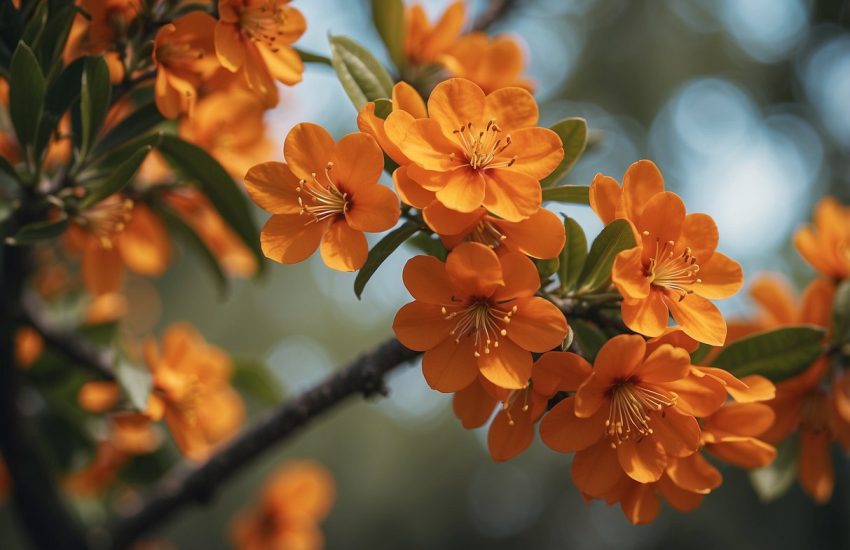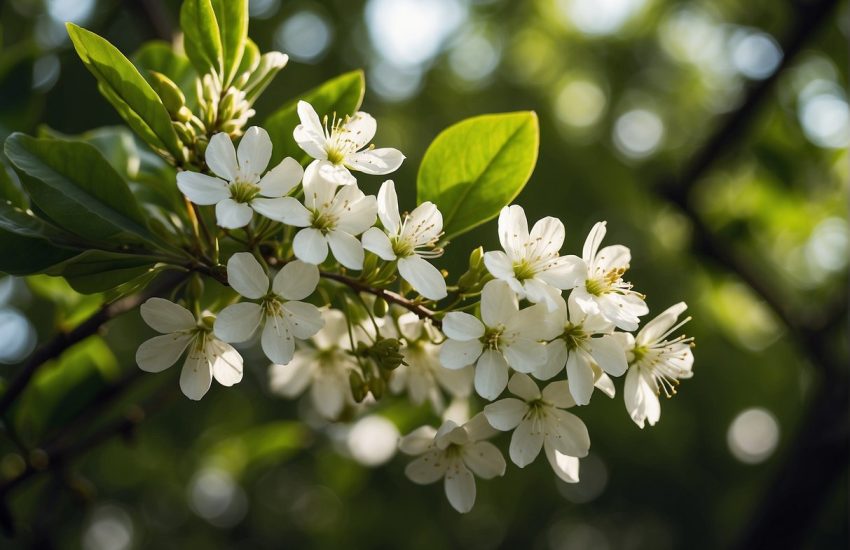Trees in Florida with Orange Flowers: A Guide to Identifying Them
Florida is home to a diverse range of trees, with many unique characteristics that make them stand out. One of the most striking features of some trees in Florida is their bright orange flowers. These trees are not only beautiful to look at but also play an important role in the state’s ecosystem.

One such tree is the Royal Poinciana, also known as the Flamboyant Tree. This tree is native to Madagascar but has been widely planted in Florida for its stunning display of orange-red flowers. The Royal Poinciana can grow up to 40 feet tall and has a wide canopy that provides shade during the hot summer months.
Another tree with orange flowers that is commonly found in Florida is the Tabebuia Tree. This tree produces clusters of trumpet-shaped flowers that range in color from bright orange to yellow. The Tabebuia Tree is also known for its medicinal properties, with its bark being used to treat a variety of ailments. Overall, trees with orange flowers are a beautiful addition to Florida’s natural landscape and are worth exploring further.
Iconic Orange-Flowered Trees of Florida
Florida is known for its beautiful and diverse flora, including a number of trees with stunning orange flowers. Here are some of the most iconic orange-flowered trees of Florida:
Royal Poinciana
The Royal Poinciana (Delonix regia) is a majestic tree that can grow up to 40 feet tall and 60 feet wide. It is known for its striking orange-red flowers that bloom in the spring and summer, creating a stunning display of color. The tree is native to Madagascar but has been widely planted in Florida and other tropical regions around the world.
Geiger Tree
The Geiger Tree (Cordia sebestena) is a small to medium-sized tree that is native to Florida and other parts of the Caribbean. It is known for its bright orange flowers that bloom year-round, making it a popular choice for landscaping. The tree can grow up to 25 feet tall and has a dense, round canopy.
African Tulip Tree
The African Tulip Tree (Spathodea campanulata) is a large, fast-growing tree that is native to tropical Africa. It is known for its large, showy orange-red flowers that bloom in the spring and summer. The tree can grow up to 80 feet tall and has a spreading canopy that provides ample shade.
Overall, these orange-flowered trees are a beautiful addition to any landscape in Florida. Whether you choose the majestic Royal Poinciana, the year-round blooms of the Geiger Tree, or the stunning African Tulip Tree, you can be sure that you will have a tree that will provide beauty and shade for years to come.
Cultivation and Care
Soil and Water Requirements
Trees with orange flowers in Florida thrive in well-drained soil. It is essential to ensure that the soil is moist and not waterlogged. Regular watering is necessary, especially during the late spring when the tree is in bloom. However, it is crucial not to overwater the tree as it can lead to root rot. A good rule of thumb is to water the tree once a week, but this can vary based on the weather conditions.
Sunlight and Temperature
Trees with orange flowers in Florida require full sun to grow and bloom correctly. They are warm-weather trees and can tolerate high temperatures. However, they are also drought-tolerant and can survive in dry conditions. It is essential to protect the tree from frost and cold weather, as it can damage the tree and prevent it from blooming.
Overall, cultivating and caring for trees with orange flowers in Florida requires regular watering, well-drained soil, and full sun exposure. By providing these essential elements, the tree can thrive and produce beautiful orange flowers.
Landscaping with Orange-Flowering Trees

Orange-flowering trees are a popular choice for landscaping in Florida due to their tropical appeal and visual appeal. There are several considerations to keep in mind when designing a landscape with these trees.
Design Considerations
When designing a landscape with orange-flowering trees, it is important to consider the overall aesthetic of the area. These trees are ornamental and can be used to add a pop of color to a tropical landscape. They are also great for patios and other outdoor living spaces, providing shade and visual interest.
Tree Placement
Tree placement is an important consideration when using orange-flowering trees in landscaping. These trees can be used as shade trees, but they should be planted in areas where they will not interfere with other plants or structures. They should also be placed in areas where they will receive adequate sunlight and water.
In central Florida, orange-flowering trees such as the Tabebuia are popular for their vibrant orange blooms. These trees are best suited for well-draining soils and full sun exposure. In south Florida, the Royal Poinciana is a popular choice for its showy orange-red blooms. These trees are best suited for coastal areas with sandy soils and full sun exposure.
Overall, orange-flowering trees can add a touch of tropical elegance to any landscape. With proper design and placement, they can provide both shade and visual appeal.
Wildlife and Ecological Benefits

Attracting Pollinators
Trees with orange flowers are known to attract a variety of pollinators, including butterflies and hummingbirds. These pollinators play a crucial role in the reproduction of many plant species, including trees. By attracting these pollinators, trees with orange flowers help to ensure the continuation of their own species, as well as other plant species in the area.
Environmental Impact
Trees with orange flowers also have a number of environmental benefits. For example, they provide shade, which can help to regulate temperatures and reduce the need for air conditioning. In addition, many trees with orange flowers are drought-tolerant, which means that they can survive in areas with limited water resources.
Furthermore, the fragrant flowers of these trees can have a positive impact on the local ecosystem. They can attract a variety of insects, including bees and butterflies, which can help to pollinate other plants in the area. Additionally, the scent of the flowers can help to mask other odors, which can be particularly beneficial in urban areas.
Overall, trees with orange flowers provide a number of ecological benefits, including attracting pollinators, providing shade, and having a positive impact on the local ecosystem. By planting more of these trees, individuals can help to support the local environment and promote biodiversity.


